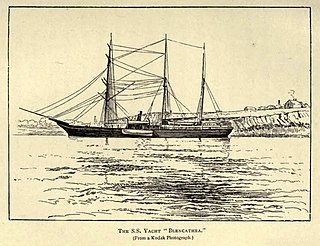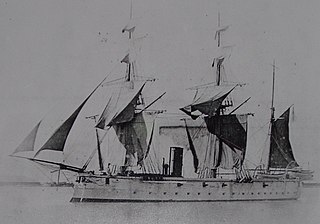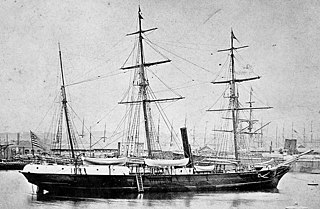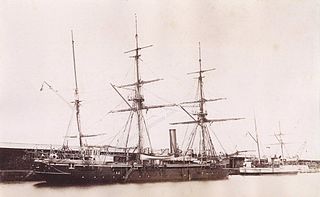Four ships of the Royal Navy have borne the name HMS Newport after the Welsh city of Newport:

Admiral Sir Astley Cooper Key, was a Royal Navy officer. As a junior officer he saw action at the Battle of Vuelta de Obligado in November 1845 during the Anglo-French blockade of the Río de la Plata and took part at the Battle of Bomarsund in August 1854 and the Bombardment of Sveaborg in August 1855 during the Crimean War. He also went ashore with the naval brigade to take part in the Battle of Canton in December 1857 during the Second Opium War. He later commanded a specially-formed Baltic Fleet created in February 1878 to intimidate Russia from entering Constantinople during the closing stages of the Russo-Turkish War. He became First Naval Lord in August 1879 in which role he was primarily interested in administration and technology rather than strategy: he kept the cost of running the Navy within budgets, sanctioned the construction of six Admiral-class battleships and ensured the Navy was properly prepared for the Panjdeh Incident in 1885 when Russian forces seized Afghan territory at Panjdeh.
Vice-Admiral Philip Howard Colomb, RN. Born in Knockbrex, near Gatehouse of Fleet, Dumfries and Galloway, Scotland, he was a Royal Navy officer, historian, critic and inventor. He was the son of General George Thomas Colomb (1787–1874). His younger brother Sir John Colomb was also a soldier and strategist of the Royal Navy.
Five ships of the Royal Navy and an air station of the Royal Naval Air Service have borne the name HMS Landrail, another name for the bird more commonly named a corn crake:

The Philomel-class gunvesselHMS Newport was launched in Wales in 1867. Having become the first ship to pass through the Suez Canal, she was sold in 1881 and renamed Pandora II. She was purchased again in about 1890 and renamed Blencathra, taking part in expeditions to the north coast of Russia. She was bought in 1912 by Georgy Brusilov for use in his ill-fated 1912 Arctic expedition to explore the Northern Sea Route, and was named Svyataya Anna, after Saint Anne. The ship became firmly trapped in ice; only two members of the expedition, Valerian Albanov and Alexander Konrad, survived. The ship has never been found.

HMS Philomel, later HMNZS Philomel, was a Pearl-class cruiser. She was the fifth ship of that name and served with the Royal Navy. After her commissioning in 1890, she served on the Cape of Good Hope Station and later with the Mediterranean Fleet.
Six ships of the Royal Navy have borne the name HMS Philomel, after Philomela, a figure in Greek mythology:

HMS Dryad was a 4-gun Amazon-class screw sloop, launched at Devonport in 1866. She served on the East Indies and North American Stations, taking part in the Abyssinian War, a confrontation with the French at Tamatave and the Egyptian War. She was sold for breaking in 1885.

HMS Melita was a Royal Navy Mariner-class composite screw sloop of 8 guns, launched in 1888 and commissioned in 1892. She was the only significant Royal Navy warship ever to be built in Malta Dockyard, She was renamed HMS Ringdove in 1915 as a salvage vessel and in 1920 was sold to the Falmouth Docks Company, which changed her name to Ringdove's Aid. She was sold again in 1926 to the Liverpool & Glasgow Salvage Association, renamed Restorer, and finally broken up in 1937, 54 years after her keel was laid.
Eleven ships of the Royal Navy have borne the name HMS Plover, after the species of bird, the Plover:
Six ships of the Royal Navy have borne the name HMS Griffon, an alternative spelling of the legendary creature, the Griffin. Another ship was planned, but later cancelled and reordered from a different dockyard:

HMS Mullett was a Royal Navy 5-gun Philomel-class wooden screw gunvessel launched in 1860. She served on the coast of West Africa and on the North America and West Indies Station before being sold in 1872 at Hong Kong for mercantile use. As the sailing ship Formosa she sailed in the Far East before being converted to a magazine in Melbourne.

HMS Sparrowhawk was a Vigilant-class second-class despatch/gunvessel launched on 9 February 1856 at Limehouse, England and served at various stations in the Far East. By the spring of 1865, her rig was a converted to that of a three-masted barque. She was sold in 1872, converted to a sailing barque in mercantile service, and was later a coal lighter in Australia.

HMS Eclipse was a four-gun Cormorant-class first-class gunvessel launched in 1860 from the shipyard of J. Scott Russell & Co., Millwall. She served on the Australia Station, took part in the Second Taranaki War, including contributing men to a naval brigade which attacked the Maori stronghold at Gate Pā. The entire class were never satisfactory as gunvessels, partly due to their excessive draught, and Eclipse was broken up at Sheerness in 1867, only seven years after her launch.

The Philomel-class gunvessel was a class of wooden-hulled screw-driven second-class gunvessels built for the Royal Navy between 1859 and 1867, of which 26 were ordered but only 20 completed. They had a mixed history, with some serving for as little as 5 years, and others surviving into the 1880s. Two of the class were sold and used as Arctic exploration vessels, both eventually being lost in the ice.

HMS Rambler was an Algerine-class gunvessel of the Royal Navy, built by John Elder & Co., Glasgow and launched on 26 January 1880. She was commissioned as a survey vessel in 1884 and served in Chinese waters during the 1880s and 1890s. She provided men to a naval brigade during the Boer War and was sold on 23 January 1907. The work of this vessel is now remembered in Hong Kong by the Rambler Channel near Tsing Yi.

HMS Nimble was a wooden Philomel-class gunvessel of the Royal Navy. She was equipped with 5 guns. She became a drill ship for the Royal Naval Reserve at Hull in 1885 and was disposed of in 1906.
Philomel is another name for Philomela, a character from Greek mythology. It may refer to:
Ten ships of the Royal Navy have borne the name HMS Dart, after the River Dart in Devon:










